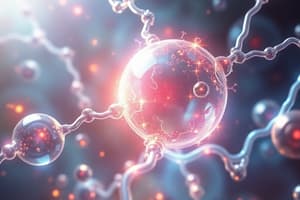Podcast
Questions and Answers
What happens when the left ventricle is generating its highest pressure in the cardiac cycle?
What happens when the left ventricle is generating its highest pressure in the cardiac cycle?
- The ventricles are in diastole.
- The semilunar valves are closed. (correct)
- The atrioventricular valves are open.
- The atria are in systole.
What is the function of proteins in the blood in terms of fluid exchange?
What is the function of proteins in the blood in terms of fluid exchange?
- To facilitate fluid exchange by creating an oncotic pressure gradient (correct)
- To decrease cardiac output
- To increase heart rate
- To increase blood pressure
Why is a delay in conduction at the A-V node important?
Why is a delay in conduction at the A-V node important?
- To allow the ventricles to fully relax
- To ensure that the ventricles contract after the atria (correct)
- To increase heart rate
- To allow the atria to fully contract
What would happen to cardiac output if potassium ions in the blood were to decrease?
What would happen to cardiac output if potassium ions in the blood were to decrease?
During what stage of the cardiac cycle is the ventricular muscle tissue supplied with blood via the coronary arteries?
During what stage of the cardiac cycle is the ventricular muscle tissue supplied with blood via the coronary arteries?
What percentage of the final exam will cover cumulative material?
What percentage of the final exam will cover cumulative material?
How many points is the final exam worth towards the cumulative point total?
How many points is the final exam worth towards the cumulative point total?
Which chapters from Martini's book will be covered on the cumulative portion of the exam?
Which chapters from Martini's book will be covered on the cumulative portion of the exam?
What type of questions will be on the final exam?
What type of questions will be on the final exam?
What happens during the clotting cascade phase of hemostasis?
What happens during the clotting cascade phase of hemostasis?
Flashcards are hidden until you start studying
Study Notes
Cumulative Portion of Bio212 Final Exam
- The final exam will cover Martini's Chapters 16-24 (Hole's Chapters 13-21) and consist of 100 multiple choice, true-false, and matching questions worth a maximum of 150 points.
- The cumulative part of the exam will cover material proportional to the number of lectures during the course for each topic.
Hemostasis and Blood Volume
- Average normal blood volume in adults is 5 liters, with 2 liters being formed elements (cells) and 3 liters being plasma.
- The three main phases of hemostasis are:
- Vasoconstriction
- Platelet plug formation
- Coagulation (where the clotting cascade occurs)
- Platelets secrete chemicals that cause blood vessel constriction and release calcium ions, which are vital for the clotting process.
Cardiac Conduction System
- Components of the cardiac conduction system include:
- SA node (pacemaker)
- AV node
- Bundle of His
- Purkinje fibers
- Impulse travels through the heart in the following order: SA node → AV node → Bundle of His → Purkinje fibers.
- Correct conduction is crucial for proper heart function.
Cardiac Output
- Factors affecting cardiac output include:
- Potassium ions (hyperkalemia increases CO, hypokalemia decreases CO)
- Calcium ions (increase CO)
- Epinephrine/norepinephrine (increase CO)
- Thyroid hormone (increase CO)
- Body temperature (increase in body temperature increases CO)
- Increases or decreases in these substances affect cardiac output.
Cardiac Cycle
- Events in the heart during atrial and ventricular systole and diastole include:
- Contraction or relaxation of muscle
- Opening or closing of valves
- Changes in pressure within chambers
- Relationship to EKG
- Isovolumetric contraction occurs when the ventricle is generating its highest pressure.
- When the left ventricle is generating its highest pressure, the aortic valve is open, and the mitral valve is closed.
- When the left ventricle is generating its lowest pressure, the aortic valve is closed, and the mitral valve is open.
Pacemaker of the Heart
- The SA node is the pacemaker of the heart, firing at a rate of 60-100 times per minute.
- The AV node fires at a rate of 40-60 times per minute.
- Purkinje fibers fire at a rate of 20-40 times per minute.
- A delay in conduction occurs at the AV node to ensure proper contraction of the ventricles.
- If the SA node fails, the AV node would take over as the pacemaker.
Electrocardiogram
- The EKG relates to events happening in the heart as follows:
- P wave: atrial depolarization
- QRS complex: ventricular depolarization
- T wave: ventricular repolarization
Blood Pressure Homeostasis
- An increase or decrease in blood pressure affects cardiac output.
- The body compensates for changes in cardiac output through:
- Changes in vasodilation/constriction
- Nervous system involvement
- A severe, sudden drop or rise in systemic blood pressure triggers a compensatory response to maintain homeostasis.
Blood Proteins and Fluid Exchange
- Blood proteins play a crucial role in fluid exchange.
- A decrease in protein concentration affects fluid exchange, leading to edema or swelling.
- An increase in protein concentration affects fluid exchange, leading to dehydration.
Intestinal Blood Supply
- Major arteries supplying the small and large intestines include:
- Superior mesenteric artery
- Inferior mesenteric artery
- Major veins draining the small and large intestines include:
- Superior mesenteric vein
- Inferior mesenteric vein
- All these veins drain into the hepatic portal vein.
Coronary Arteries
- Ventricular muscle tissue is supplied with blood via coronary arteries during diastole.
Studying That Suits You
Use AI to generate personalized quizzes and flashcards to suit your learning preferences.




